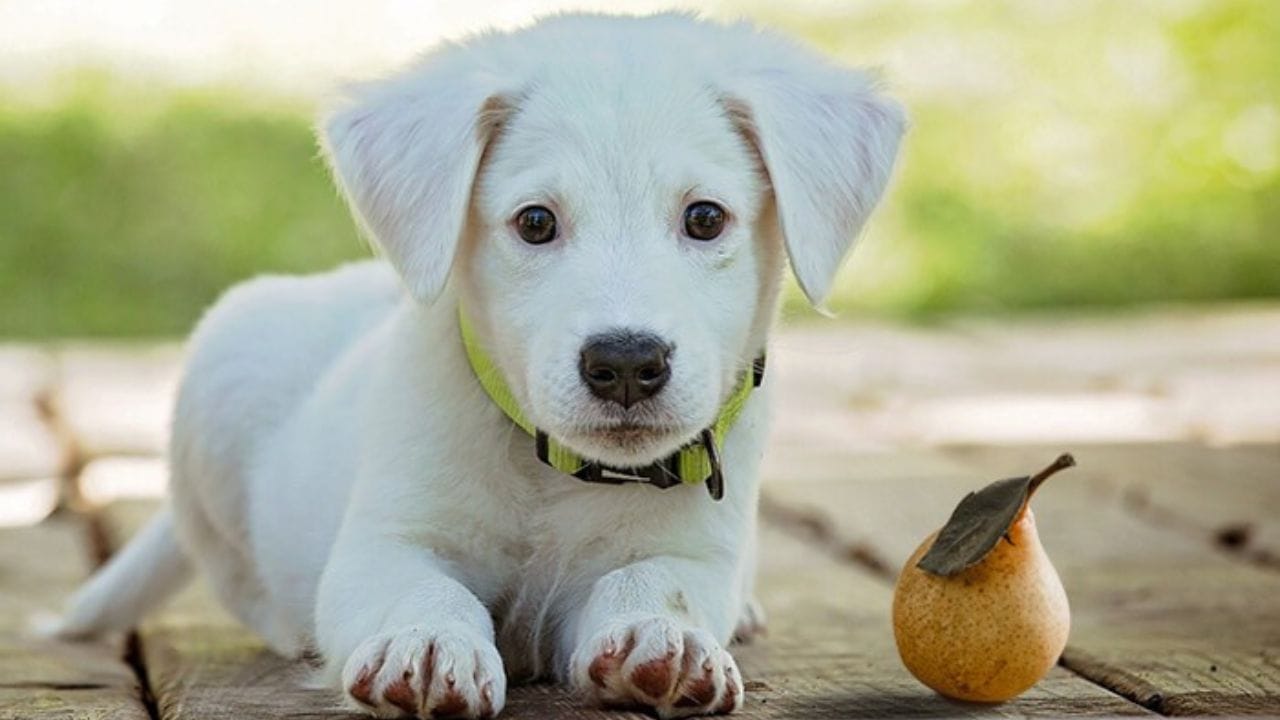Dogs are known to be omnivores, meaning they can eat both meat and plant-based foods. While their primary diet should be meat-based, many dog owners often wonder if it is safe to feed their furry friends fruits or vegetables. One fruit that often comes to mind is pears. So, can dogs have pears?

The answer is yes, dogs can eat pears. Pears are a great source of vitamins C and K, fiber, and antioxidants. However, it is important to note that pears should only be given to dogs in moderation and as a treat. Too much fruit can upset a dog's stomach and cause diarrhea or vomiting. Additionally, the seeds of a pear contain trace amounts of cyanide, which can be toxic to dogs if consumed in large quantities.
When feeding a dog pears, it is important to remove the seeds and core first. The skin can be left on or removed, depending on the preference of the dog. It is also recommended to cut the pear into small, bite-sized pieces to prevent choking. As with any new food, it is important to introduce pears slowly and in small quantities to ensure that the dog does not have an adverse reaction.
Canine Nutrition and Diet
Importance of a Balanced Diet
A balanced diet is essential for a dog's overall health and well-being. A balanced diet should include all the necessary nutrients such as protein, fiber, vitamins, and minerals. Dogs require a diet that is high in protein to maintain their muscle mass and support their immune system. A balanced diet also helps to maintain healthy skin, coat, and teeth.
It is important to note that dogs have different nutritional requirements compared to humans. Therefore, it is crucial to feed them a diet that is specifically designed for their needs. A well-balanced diet can help to prevent health problems such as obesity, diabetes, and heart disease.

Role of Fruits in Canine Health
Fruits are a great source of fiber, vitamins, and minerals. They can be a healthy addition to a dog's diet when given in moderation. Pears are one of the fruits that dogs can safely consume. They are low in calories and high in fiber, which makes them a good choice for dogs that are trying to lose weight.
Pears also contain vitamin C, which is an important antioxidant that helps to boost the immune system. They are also a good source of potassium, which is an electrolyte that helps to maintain healthy blood pressure and heart function.
However, it is important to note that fruits should not be the main source of nutrition for dogs. They should be given in moderation as a treat or supplement to a well-balanced diet. Overfeeding fruits can lead to digestive problems such as diarrhea and upset stomach.
In conclusion, a well-balanced diet is crucial for a dog's overall health and well-being. Fruits such as pears can be a healthy addition to a dog's diet when given in moderation. It is important to consult with a veterinarian before making any changes to a dog's diet.
Benefits of Pears for Dogs
Pears are a popular fruit among humans, but can dogs safely consume them? The answer is yes, in moderation. Pears offer several nutritional benefits for dogs and can be a healthy addition to their diet.
Nutritional Value of Pears
Pears are a low-fat, low-calorie fruit that are high in fiber, making them a great snack option for dogs. They are also a good source of vitamin C, which can help boost the immune system, and potassium, which supports healthy muscle function. Pears also contain copper, which is important for maintaining healthy bones and connective tissues.
Health Benefits of Pear Consumption
In addition to their nutritional value, pears offer several health benefits for dogs. The fiber in pears can aid in digestion and help regulate bowel movements. This can be particularly beneficial for dogs with digestive issues or constipation. Pears also contain antioxidants, which can help reduce inflammation and support overall health.
It is important to note that while pears can be a healthy addition to a dog's diet, they should be given in moderation. Too much fruit can upset a dog's stomach and cause diarrhea or other digestive issues. It is also important to remove the seeds and core of the pear, as they can be a choking hazard and contain trace amounts of cyanide.
Overall, pears can be a safe and healthy treat for dogs when given in moderation. As with any new food, it is important to introduce pears slowly and monitor your dog's reaction. If you notice any signs of digestive upset or allergic reaction, discontinue feeding pears and consult with your veterinarian.
Potential Risks and Precautions
When it comes to feeding dogs fruits, pears are often considered a safe and healthy option. However, there are still some potential risks associated with feeding pears to dogs. In this section, we will discuss some of the hazards of feeding pears to dogs and the precautions that should be taken to minimize these risks.
Hazards of Pear Seeds
One of the main concerns when feeding pears to dogs is the risk of choking or intestinal blockage from the seeds. Pear seeds contain a small amount of cyanide, which can be toxic in large quantities. While the amount of cyanide in pear seeds is not enough to harm most dogs, the seeds can still pose a choking hazard or cause blockages in the digestive tract.
To minimize the risk of choking or blockages, it is recommended to remove the seeds from the pear before feeding it to your dog. If you are unsure how to do this, simply cut the pear into slices and remove the core and seeds from each slice before giving it to your dog.
Sugar Content and Obesity Risk
Another potential risk associated with feeding pears to dogs is the high sugar content. While pears are a healthy source of natural sugars, too much sugar can lead to weight gain and other health problems in dogs. It is important to feed pears to your dog in moderation and as part of a balanced diet.
If your dog is overweight or has a history of weight gain, it may be best to avoid feeding them pears altogether or to limit their intake to small amounts as an occasional treat.
Choking Hazards and Proper Preparation
In addition to the hazards posed by the seeds, pears can also pose a choking hazard if they are not prepared properly. To minimize the risk of choking, it is important to cut the pear into small, bite-sized pieces before feeding it to your dog. This will also help to ensure that the pear is properly digested and absorbed by your dog's body.
Overall, pears can be a healthy and nutritious addition to your dog's diet when fed in moderation and prepared properly. By taking the necessary precautions and being aware of the potential risks, you can safely incorporate pears into your dog's diet and provide them with a tasty and healthy treat.
Feeding Guidelines for Pears
Pears can be a refreshing and healthy treat for dogs, but it's important to follow some guidelines to ensure they are safe and nutritious. Here are some tips for feeding your dog pears.
Recommended Pear Serving Size
When giving your dog pears, it's important to keep the serving size small. A quarter to half a pear is a good size for most dogs, depending on their size and appetite. It's also important to remove the seeds and core, as these can be a choking hazard and contain trace amounts of cyanide.
Frequency of Pear Treats
Pears should be given to dogs as an occasional treat and not as a substitute for their regular meals. Too much fruit can upset their stomach and cause diarrhea. It's recommended to limit pear treats to once or twice a week.

Types of Pears and Preparation Methods
Dogs can eat most types of pears, including Asian pears, Bartlett pears, and Anjou pears. However, they should not be given canned pears, as these often contain added sugar and preservatives. It's best to give your dog fresh, ripe pears that are washed and sliced into small pieces.
To make the pear more appealing to your dog, you can try slicing it into thin pieces or mashing it into a puree. Some dogs may prefer the texture of cooked pears, which can be boiled or baked without added sugar or spices.
Overall, pears can be a safe and refreshing treat for dogs when given in moderation and prepared properly. If you have any concerns about feeding your dog pears, consult with your veterinarian.
Signs of Adverse Reactions
When feeding dogs with pears, it is essential to monitor them for any adverse reactions. While pears are generally safe for dogs, some may experience an allergic reaction or digestive issues. Here are some signs to watch out for:
Symptoms to Monitor After Pear Consumption
Diarrhea
Dogs may experience diarrhea after consuming pears. Diarrhea is characterized by loose, watery stools, and it can be caused by the high fiber content in pears. If the diarrhea persists for more than a day, it is advisable to consult a veterinarian.
Lethargy
Lethargy is a common symptom of digestive issues in dogs. If a dog becomes lethargic after consuming pears, it could indicate that their digestive system is having trouble processing the fruit. If the lethargy persists for more than a day, it is advisable to consult a veterinarian.
Hives
Some dogs may have an allergic reaction to pears, which can cause hives. Hives are raised, red, and itchy bumps on the skin. If a dog develops hives after consuming pears, it is essential to consult a veterinarian immediately.
When to Consult a Veterinarian
If a dog experiences any of the symptoms mentioned above after consuming pears, it is advisable to consult a veterinarian. Additionally, if a dog has a pre-existing medical condition, it is advisable to consult a veterinarian before introducing pears into their diet. Veterinarians can help diagnose and treat any adverse reactions that a dog may experience after consuming pears.
In conclusion, while pears are generally safe for dogs, it is essential to monitor them for any adverse reactions. If a dog experiences diarrhea, lethargy, or hives after consuming pears, it is advisable to consult a veterinarian immediately.
Conclusion
In conclusion, pears can be a nutritious and enjoyable treat for dogs when offered in moderation and prepared correctly. They provide a good source of vitamins, fiber, and antioxidants, which can contribute positively to a dog's health. However, it's crucial to remove the seeds and core to prevent any risk of choking or cyanide poisoning and to introduce pears gradually into the dog's diet to monitor for any adverse reactions.
As with any dietary addition, the key is moderation to avoid digestive issues or potential allergic reactions. Always consider your dog's specific health needs and consult with a veterinarian if you have any concerns about introducing new foods into their diet. By following these guidelines, pears can be a safe and enjoyable addition to your dog's dietary regimen, offering a sweet treat that supports their overall well-being.




